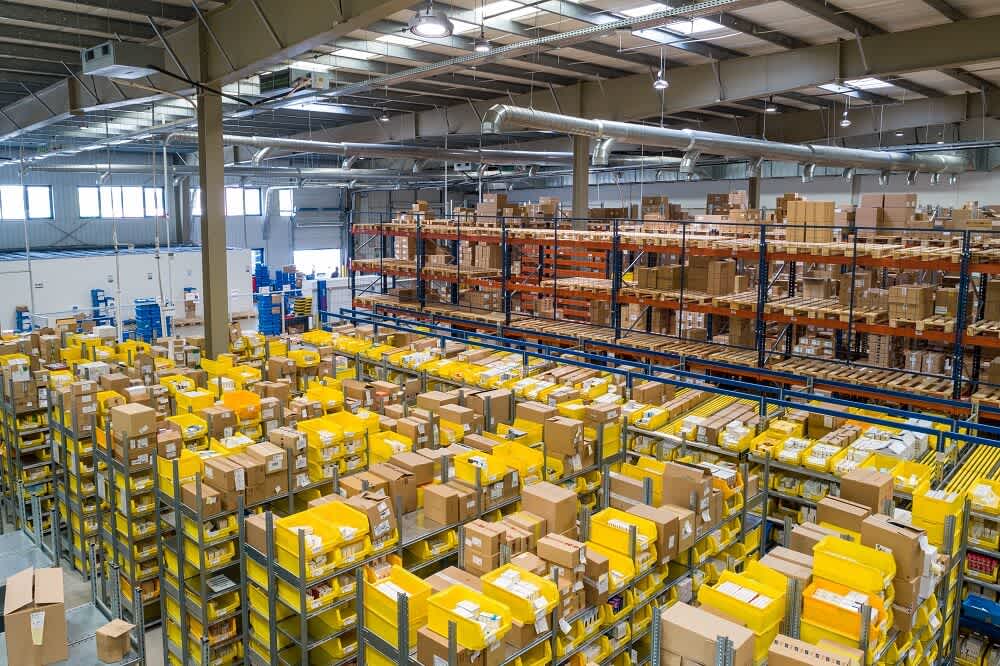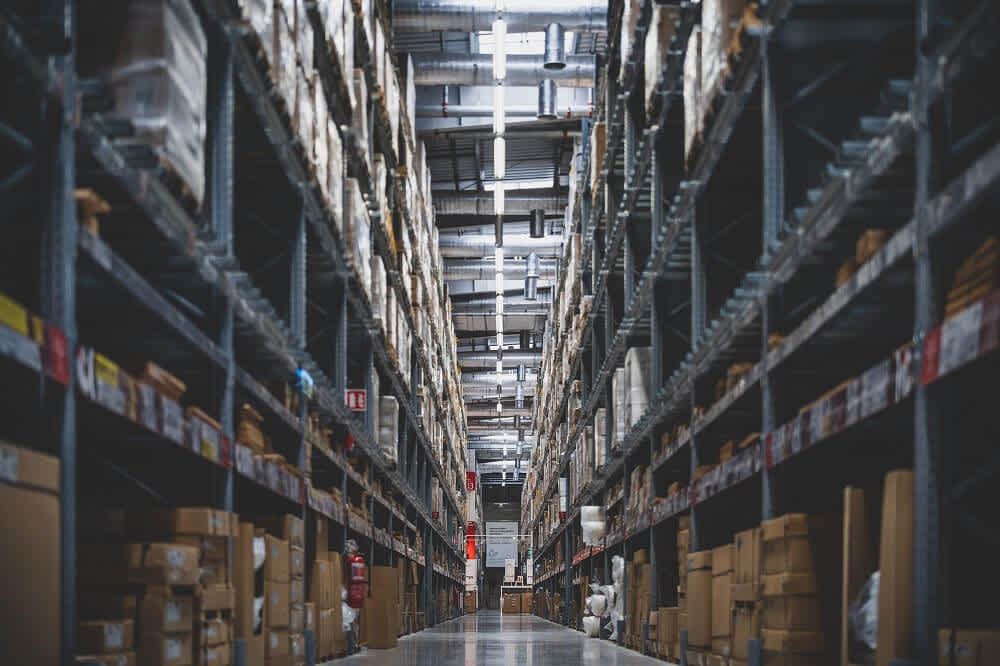
Last updated: October 06, 2022
The eCommerce industry is experiencing steady growth as more people start their eCommerce businesses and eCommerce retailers jostle to level up their businesses in the post-pandemic future.
In 2021, the US made $870 billion in online transactions and saw a 14.2% increase in eCommerce sales compared to 2020 and a 50.5% growth compared to 2019.
That speaks volumes. It also means that the best time to start your eCommerce business is now. But is it that simple?
On the surface, it may seem like all you need to start an eCommerce business is to create an online store (with all the bells and whistles) and watch as sales begin to roll in. In reality, it’s more than that.
Before you build an eCommerce store, you first need to learn everything about the eCommerce business model and then implement what you’ve learned to build yourself a successful online retail store.
Table of contents
- What is eCommerce warehousing?
- Types of eCommerce warehouses
- Fulfilment centres
- Public warehouses
- Consolidated warehouses
- Bonded warehouses
- Smart warehouses
- Government warehouses
- Cooperative warehouses
- Private warehouses
What is eCommerce warehousing?
eCommerce warehousing is simply the process of storing and organising goods or products, so they're ready to be picked and shipped when ordered by your customers.

For efficient eCommerce warehousing, you will need a reliable eCommerce warehouse management system – one that understands the processes involved in the daily running of an eCommerce warehouse.
Some of the processes involved in operating an eCommerce warehouse include (but aren’t limited to) the following:
Securing store inventory or products
Tracking warehouse equipment
Managing all employees working in the warehouse
Managing inventory of raw materials and finished products (inventory management can be done via a first-in, first-out (FIFO) process)
Monitoring the entire eCommerce supply chain
Engaging and collaborating with shipping carriers
Forecasting the demand and supply of goods
Ensuring safety precautions are maintained at all times to curb accidents and to help protect inventory, equipment and employees.
When your business grows and reaches a point where it’s difficult to keep up with your order volume, you may want to outsource order fulfilment.
You don't have to do it yourself, though. Many reputable third-party logistics (3PL) providers exist out there that can help you with eCommerce order fulfilment. A good case in point is ShipStation, ShipBob, Shippo, and many more.
Note that it’s important to first understand how fulfilment services work before you outsource fulfilment. This way, you’ll know when you need to exactly outsource and which fulfilment software can easily integrate with your eCommerce store.
Types of eCommerce warehouses
Here are some of the main types of eCommerce warehouses, what they’re meant for, and their key purpose.
Fulfilment centres
Fulfilment centres act as distribution centres for receiving large inventory. Designed with specific requirements in mind, these storage spaces store large quantities of goods for a temporary period and then quickly distribute them to various customers in a few days.
Fulfilment centres are an important part of the supply chain because they help move goods within a short time. They’re also located near transportation centres for a reason – to help increase efficiency and lower delivery time.
Public warehouses
Public warehouses are great for personal or business use. That’s because they offer better value for money, as users only pay for the storage space they occupy. The only downside of public warehouses is that they're not advanced in terms of technology.
Consolidated warehouses
Considered third-party storage facilities, consolidated warehouses store various small shipments often collected from different suppliers. The small shipments are then combined into larger and more economical truckloads destined for similar geographical locations.
If you run a small business and don't have a large quantity of goods, a consolidated warehouse can come in handy.
Bonded warehouses
Bonded warehouses are warehouses where companies store their imported goods until the customs duty is paid. A company only pays customs duties when its stored products are released from a bonded warehouse. So companies can choose to store their items for short-term or long-term periods.
To importers, bonded warehouses are an ideal option to store goods duty-free until they’re bought. eCommerce retailers engaging in cross-border trading prefer bonded warehouses for their safer and secure storage.
Smart warehouses
A smart warehouse is fully automated and uses artificial intelligence (AI) technology to store inventory, manage warehousing, and fulfil orders.

Automations used in smart warehouses (such as drones and robots) can’t be compared to inventory management systems. They select and pack orders for shipment and assist with storage, weighing, and transporting goods.
Amazon and Alibaba use smart warehouses to eliminate human error and speed up order fulfilment, efficiently meeting the needs of their customers.
Government warehouses
Government warehouses are legally controlled and owned explicitly by governmental bodies. Most businesses prefer storing their items or goods in government warehouses thanks to their affordable rates.
However, if you lease a government warehouse and fail to make rent payments, the government is authorised by law to come in and sell your inventory to recoup their lost revenue.
Cooperative warehouses
Cooperative organisations (think farmers and wineries) run and operate cooperative warehouses. Anyone, including cooperative members and non-members, can store goods in a cooperative warehouse. However, members can store their goods at much lower rates.
Private warehouses
Private warehouses are exactly that, private. You’ll find distributors, wholesalers, and manufacturers owning private warehouses.
Which eCommerce warehouse is ideal for your business?
It depends on several factors, including the resources you can dedicate to your eCommerce logistics strategy, available capital, and the size of your business.
If you’re solely responsible for driving customer experience for your business, and your eCommerce warehouse space complements your order fulfilment process and caters to your inventory needs, then it’s best to manage your own eCommerce warehouse.
But if you’re a growing business looking to scale greater heights in the future, it may be time to consider using a third-party logistics fulfilment centre or provider.
Multinational companies such as Amazon employ the use of distribution centres, and for a good reason – to help streamline their order fulfilment and enhance their inventory management.
Overall, whatever eCommerce warehouse you choose, make sure it can deliver your orders quickly, reduce your fulfilment costs, and simplify your daily tasks.
What are the benefits of eCommerce warehousing?
When starting your business, it may seem illogical to invest in eCommerce warehousing. But when you nearly reach the pinnacle of your business, eCommerce warehousing is inevitably necessary and beneficial.
Having your own eCommerce warehouse space ensures your customers receive products faster. All you do is collect orders from your customers and then ship them to the closest distribution centre.
Leveraging the power of warehouses also helps you take bulk shipping discounts, which makes eCommerce shipping costs more manageable.
Turning to eCommerce warehousing also reduces the hassle (and the risk) of storing valuable products in your garage. All you worry about is shipping your store inventory to your multiple eCommerce warehouses.

eCommerce warehousing improves accurate reporting on the current status of your inventory. Additionally, you'll get a better understanding of your inventory turnover rates, and you won’t lose items.
It’s also easier to stay more organised when you have more storage space and a better organisational system. A good eCommerce warehouse space takes the time-consuming inventory management process off your hands and monitors your products for you.
Here are some of the problems your business is likely to run into without having an eCommerce warehouse:
You run out of storage space
You risk losing your store inventory to theft or mishandling
You risk shipping the wrong inventory to your customers
You end up with more excess inventory or run out of stock
So, how do you choose the right eCommerce warehouse? Here are several essential factors to consider when shopping for one near you.
How to choose an eCommerce warehouse
Identifying the different types of eCommerce warehouses is just half the journey. You must also consider which type of warehouse suits your eCommerce business and meets your business goals and needs.
But first: what are the factors to consider when choosing an eCommerce warehouse?
1. Location
Setting up an eCommerce warehouse within a reasonable distance of your customers reduces logistical costs, which can increase suddenly. Choosing a convenient location means customers' orders get delivered fast, and you minimise transportation costs.
A suitable location near major transit systems (think shipping ports and railways) is also helpful, especially in meeting your specific business needs.
Customers value fast and reliable services, as well as the quality of products. Provide both, and you’ll have the edge over your competition.
2. Access to warehouse
While the location of the warehouse matters a great deal, so is access to the warehouse. Orders can be delayed if the warehouse isn’t easily accessible by nearby roads and motorways, etc.
So before choosing an eCommerce warehouse, check out the road and traffic conditions nearby (sitting in a traffic jam for hours on end increases high petrol consumption and also slows down the delivery process).
3. Integrated eCommerce warehousing solution
A suitable eCommerce warehouse should have integrated warehousing features, including an optimised warehouse setup, highly trained employees, and reliable transport facilities.
Before choosing an eCommerce warehouse, ensure these integrated warehousing solutions are part of the package. They help optimise your warehouse operations and solve warehouse management problems.
4. Technology
The impact of technology on how eCommerce logistics work is huge. Technology automates your warehouse operations, including inventory management and real-time tracking of store inventory.
Before selecting an eCommerce warehouse, ensure it can integrate with your sales channels, warehouse management system, and inventory management software. You can speed up your entire order fulfilment process with the right technological solutions.
5. Suitability for business size
Choose an eCommerce warehouse that can handle your order volume and has enough warehouse space to store your inventory.
An eCommerce warehouse designed to handle smaller order volumes doesn't have the capacity or the infrastructure to handle large shipments. So, choose an eCommerce warehouse depending on the size of your business.
6. Productivity and efficiency
Choose an eCommerce warehouse with highly-trained staff who follow standard operating procedures (SOPs). All warehouse operations depend on the workforce. So, poor eCommerce warehousing processes are a tell-tale sign of its wanting productivity and efficiency levels.
With the right warehouse workforce, you can increase productivity, efficiency, and the quality of your eCommerce order fulfilment processes.
7. Security and protection
Accidents can happen, even in the best eCommerce warehouses. So to protect your inventory against theft, natural calamities, shrinkage, or breakage, choose a warehouse with the best security features.
A secure and well-protected eCommerce warehouse should be equipped with devices and gadgets to provide utmost security, including security cameras, multiple power backup systems, metal detectors at entrances, etc.
There are many other factors to consider before opting for the best eCommerce warehouse for your business. But whichever option you choose, remember you can change your decisions anytime.
Businesses are dynamic, and you can always consider changing your warehouse type depending on your target market, supply chain, budget, and specific business needs.
Best eCommerce warehouse management practices to keep in mind
Whether you choose a public warehouse or bonded warehouse for your business needs, you need to keep several eCommerce warehouse management practices in mind.
These practices are necessary for your operations to run well and efficiently, as they help eliminate poor eCommerce warehouse processes.
Here are some tips to help you manage your eCommerce warehouse:
Set up your inventory minimums
Use an eCommerce warehouse management system
Try out multiple eCommerce management systems
Distribute your store inventory in multiple warehouse locations
Integrate your eCommerce store with other tools
Let's look at these eCommerce warehouse management practices in more detail.
1. Set up your inventory minimums
As a beginner eCommerce merchant, it's difficult to estimate how much store inventory you need to run your business. (After all, you lack enough historical data to run your estimations.)
On the one hand, you risk losing money when you buy so much inventory. And on the other, you risk running out of stock or missing out on sales when you have limited store inventory.
To find a balance, set up inventory minimums. When your inventory reaches a certain level, your warehouse management system automatically places an order for more inventory. Taking such precautions will help you protect against running out of stock.
2. Use an eCommerce warehouse management system
A reliable eCommerce warehouse management system monitors your daily warehouse operations by doing the following:
Streamlining your order fulfilment
Forecasting your store inventory
Managing your eCommerce supply chain
Providing real-time insights on product availability and inventory levels
3. Try out multiple eCommerce management systems
Finding the right eCommerce management system for your business model can easily grow and scale your business to newer heights. So, try out multiple eCommerce management systems to help you find the right one.
There’s no shortage of warehouse management systems. For example, if you run a direct-to-consumer eCommerce business, go for your nearest 3PL provider or fulfilment centre. But make sure to test out different ones until you find the right one for you.
4. Distribute your store inventory in multiple warehouse locations
Customers should be able to collect their orders from the nearest possible warehouse. So make sure to store your inventory across several distribution centres to help your customers get their products faster. This also improves your customer experience and helps lower eCommerce shipping costs.
5. Integrate your eCommerce store with other tools
To streamline your overall workflow, it’s important to also integrate your eCommerce store not only with a warehouse management system but also with other tools.
As this helps automate various tasks, including:
Managing your inventory across multiple sales channels
Automatically ordering more store inventory before you run out of stock
Sending your customers' shipment notifications and order updates.
Think about it. Nothing delays your order fulfilment and wastes your money more than running poor warehouse processes. Embodying these best practices will help improve your warehouse management systems.
Conclusion
It's easy to overlook eCommerce warehousing, especially when the excitement and stress of running an eCommerce store (for the first time) takes over. But having an eCommerce warehouse is the missing piece to the eCommerce puzzle that’ll positively impact your bottom line.
There’s no better way to meet your customer's expectations and save money while at it than having a good eCommerce warehouse management system.
And it doesn't matter whether you work closely with a third-party logistics provider for order fulfilment or you store inventory in-house, these strategies and basics of eCommerce warehousing in this guide will come in handy for your business.
Written by

Sam founded his first startup back in 2010 and has since been building startups in the Content Marketing, SEO, eCommerce and SaaS verticals. Sam is a generalist with deep knowledge of lead generation and scaling acquisition and sales.


